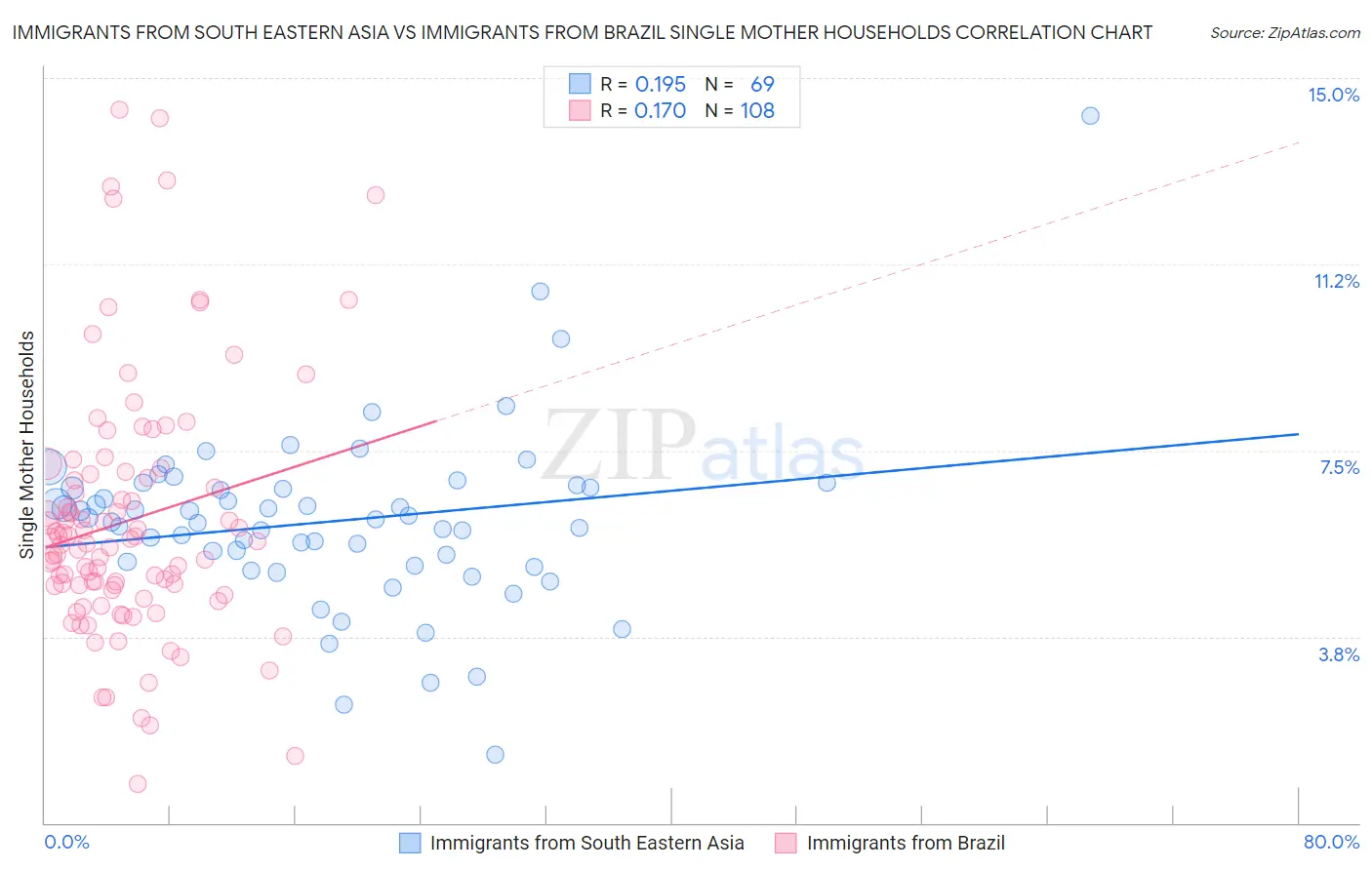Immigrants from South Eastern Asia vs Immigrants from Brazil Single Mother Households
COMPARE
Immigrants from South Eastern Asia
Immigrants from Brazil
Single Mother Households
Single Mother Households Comparison
Immigrants from South Eastern Asia
Immigrants from Brazil
6.3%
SINGLE MOTHER HOUSEHOLDS
52.2/ 100
METRIC RATING
172nd/ 347
METRIC RANK
6.1%
SINGLE MOTHER HOUSEHOLDS
78.9/ 100
METRIC RATING
153rd/ 347
METRIC RANK
Immigrants from South Eastern Asia vs Immigrants from Brazil Single Mother Households Correlation Chart
The statistical analysis conducted on geographies consisting of 510,269,727 people shows a poor positive correlation between the proportion of Immigrants from South Eastern Asia and percentage of single mother households in the United States with a correlation coefficient (R) of 0.195 and weighted average of 6.3%. Similarly, the statistical analysis conducted on geographies consisting of 342,403,937 people shows a poor positive correlation between the proportion of Immigrants from Brazil and percentage of single mother households in the United States with a correlation coefficient (R) of 0.170 and weighted average of 6.1%, a difference of 3.5%.

Single Mother Households Correlation Summary
| Measurement | Immigrants from South Eastern Asia | Immigrants from Brazil |
| Minimum | 1.4% | 0.79% |
| Maximum | 14.2% | 14.4% |
| Range | 12.9% | 13.6% |
| Mean | 6.1% | 6.1% |
| Median | 6.1% | 5.7% |
| Interquartile 25% (IQ1) | 5.2% | 4.7% |
| Interquartile 75% (IQ3) | 6.8% | 7.0% |
| Interquartile Range (IQR) | 1.6% | 2.2% |
| Standard Deviation (Sample) | 1.8% | 2.6% |
| Standard Deviation (Population) | 1.8% | 2.6% |
Demographics Similar to Immigrants from South Eastern Asia and Immigrants from Brazil by Single Mother Households
In terms of single mother households, the demographic groups most similar to Immigrants from South Eastern Asia are Afghan (6.3%, a difference of 0.040%), Immigrants from Oceania (6.3%, a difference of 0.26%), Puget Sound Salish (6.3%, a difference of 0.66%), Immigrants from Chile (6.3%, a difference of 0.69%), and Brazilian (6.2%, a difference of 0.78%). Similarly, the demographic groups most similar to Immigrants from Brazil are Pakistani (6.1%, a difference of 0.040%), Immigrants from Philippines (6.1%, a difference of 0.070%), White/Caucasian (6.1%, a difference of 0.40%), Native Hawaiian (6.1%, a difference of 0.63%), and Chilean (6.1%, a difference of 0.74%).
| Demographics | Rating | Rank | Single Mother Households |
| Pakistanis | 79.2 /100 | #152 | Good 6.1% |
| Immigrants | Brazil | 78.9 /100 | #153 | Good 6.1% |
| Immigrants | Philippines | 78.5 /100 | #154 | Good 6.1% |
| Whites/Caucasians | 76.5 /100 | #155 | Good 6.1% |
| Native Hawaiians | 75.0 /100 | #156 | Good 6.1% |
| Chileans | 74.2 /100 | #157 | Good 6.1% |
| Celtics | 73.3 /100 | #158 | Good 6.1% |
| Yugoslavians | 73.1 /100 | #159 | Good 6.1% |
| Iraqis | 73.0 /100 | #160 | Good 6.1% |
| Immigrants | Germany | 72.4 /100 | #161 | Good 6.1% |
| Immigrants | Zimbabwe | 69.9 /100 | #162 | Good 6.2% |
| Alsatians | 68.7 /100 | #163 | Good 6.2% |
| Immigrants | Northern Africa | 68.0 /100 | #164 | Good 6.2% |
| Immigrants | Syria | 67.4 /100 | #165 | Good 6.2% |
| Sri Lankans | 63.9 /100 | #166 | Good 6.2% |
| Brazilians | 59.1 /100 | #167 | Average 6.2% |
| Immigrants | Chile | 58.3 /100 | #168 | Average 6.3% |
| Puget Sound Salish | 58.1 /100 | #169 | Average 6.3% |
| Immigrants | Oceania | 54.6 /100 | #170 | Average 6.3% |
| Afghans | 52.5 /100 | #171 | Average 6.3% |
| Immigrants | South Eastern Asia | 52.2 /100 | #172 | Average 6.3% |